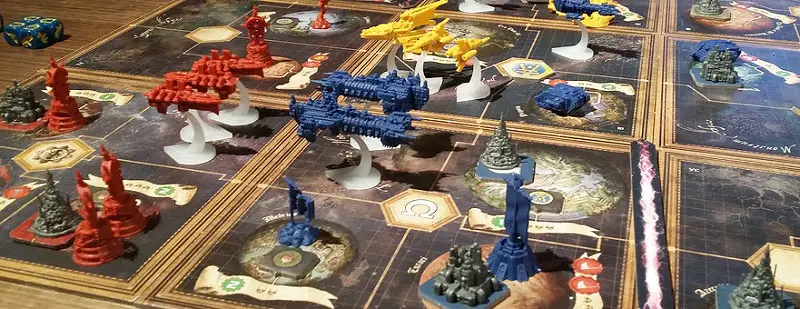
After a player moves units using an Advance Order, he must resolve a combat if he has units on an area containing both friendly and enemy units or structures (i.e., a contested area).
During combat, the player resolving the Advance Order is the attacker and the other player is the defender.
Combat in Forbidden Stars uses a combination of both dice and cards. Players begin the combat by rolling a number of dice based on their units' combat values. Then, they play combat cards to trigger special abilities and gain combat icons, dice, and combat tokens. The player with the most morale ( ) at the end of the combat is the winner and his opponent must retreat his units.
) at the end of the combat is the winner and his opponent must retreat his units.
The specific steps of combat are as follows:
I. Preparation
Players prepare for combat by performing the following substeps:
A. Roll Dice: Both the attacker and defender simultaneously roll a number of dice equal to the combined combat value of each of his unrouted units in the combat, as displayed on his faction sheet. For example, if the Ultramarines player has two Land Raiders in the combat, he rolls six dice.
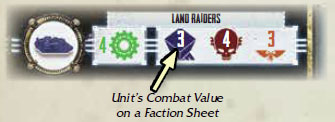
Each player organizes his rolled dice into groups of identical icons so both he and his opponent can easily evaluate the results.
B. Draw Combat Cards: Each player draws five combat cards from the top of his combat deck.
C. Reinforce Step: First the attacker and then the defender have an opportunity to place some of their reinforcement tokens near their units in the contested area. The number of reinforcement tokens that a player can place is equal to the number of units he has in the combat.
II. Execution
Players resolve up to three execution rounds by playing combat cards from their hands. During each execution round, players perform the following substeps:
A. Choose a Combat Card: The attacker and defender simultaneously choose one combat card from their hands and place them facedown in the play area.
B. Resolve a Combat Card: The attacker reveals and resolves his combat card. Then, the defender reveals and resolves his combat card.
C. Assess Damage: Starting with the attacker, both players must suffer damage equal to his opponent's total number of offence icons (
 ) from dice, combat tokens, and faceup combat cards.
) from dice, combat tokens, and faceup combat cards.Each defence icon (
 ) that a player has (from dice, combat tokens and his faceup combat cards) reduces the amount of damage suffered by one.
) that a player has (from dice, combat tokens and his faceup combat cards) reduces the amount of damage suffered by one.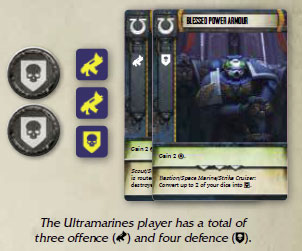
After both players have suffered damage, if only one player has units and/or bastions remaining in the area, he wins the combat and proceeds to the "Capture Structures" substep of resolution.
III. Resolution
After resolving the third execution round, players finish resolving the combat by following these substeps:
A. Determine Winner: The player with the highest total morale value wins the combat (defender wins ties), and the enemy units must retreat (explained later).
A player determines his total morale value by adding the number of his morale icons (
 ) on his dice and faceup combat cards as well as the number of morale on his faction sheet that corresponds to each of his bastions and unrouted units in the combat.
) on his dice and faceup combat cards as well as the number of morale on his faction sheet that corresponds to each of his bastions and unrouted units in the combat.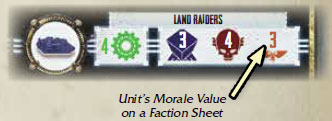
B. Capture Structures: If the attacker wins the combat, he takes control of any structures on the world by removing his opponent's structure control tokens and replacing them with his own.
C. Clean Up: Each player discards any reinforcement tokens he used to the supply and shuffles all of his combat cards back into his combat deck.
Resolving Combat Cards
All combat cards have one or two combat ability boxes. When resolving a combat card, the player first resolves all general abilities (green box), then resolves all unit abilities (brown box). He resolves each ability in the order in which it is listed, from top to bottom.
Unit abilities are always preceded by at least one unit name. To use a unit ability, the player must have at least one of the listed units in the combat, and that unit must be unrouted.

To use this unit ability, the player must have at least one Bastion, unrouted Space Marine, or unrouted Strike Cruiser in the combat.
Combat Card Icons
Most combat cards contain one or more combat icons ( ,
, ,
, ) on the left side of the card. These icons function like the icons on dice and persist until the end of the combat.
) on the left side of the card. These icons function like the icons on dice and persist until the end of the combat.
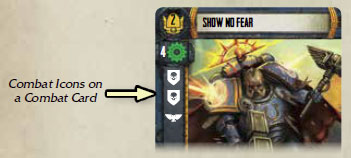
Combat Dice
When a player gains a  ,
,  , or
, or  from an ability, he takes one die from the supply of unused dice and places it by his other dice with the indicated icon faceup. When a player loses a die, he takes one of his dice with the matching icon and returns it to the supply.
from an ability, he takes one die from the supply of unused dice and places it by his other dice with the indicated icon faceup. When a player loses a die, he takes one of his dice with the matching icon and returns it to the supply.
If a game effect allows a player to gain a V, he takes a die from the supply, rolls it, and places it with his other dice.
Important: The attacker and defender are each limited to eight dice during a combat.
Combat Tokens
Some combat card abilities provide players with combat tokens, represented by combat token icons ( and
and  ). When a player gains a
). When a player gains a  or
or  , he takes a combat token from the supply and places it with the appropriate side faceup near his dice. When calculating offence or defence during combat, a player's combat tokens add to his final value.
, he takes a combat token from the supply and places it with the appropriate side faceup near his dice. When calculating offence or defence during combat, a player's combat tokens add to his final value.
All combat tokens are temporary and are returned to the supply at the end of the execution round in which they were gained.
Suffering Damage
When a player suffers damage, he must choose any one friendly unit on the area to suffer the damage. That unit must be unrouted unless all of his other units are routed. If the damage equals or exceeds the chosen unit's health value, that unit is destroyed and removed from the game board.
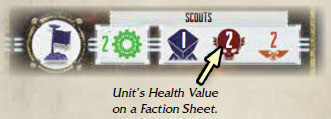
If the damage is lower than the health value of the chosen unit, that unit is routed. If the damage exceeds the health value of the chosen unit, any damage that exceeds the unit's health value must be applied to another friendly unit. The player repeats this process until either no more damage remains or no more units remain.
Important: When suffering damage during an orbital strike, any units that are not destroyed do not become routed.
Example: The Ultramarines player has two Scouts in a combat. During the first round, he must suffer three damage. He chooses one of his Scouts to suffer the damage first. He compares its two health to the three damage; because the Scout's health is equal to or less than the damage, it is destroyed. Then, the player assigns the one remaining damage to his other Scout. This unit is not destroyed but is routed instead, and the damage is ignored because the unit's health exceeds the damage.
Routed Units
Units can be routed by combat card abilities, by retreating, or by suffering damage that is less than their health value. When a unit is routed, the plastic piece is placed on its side.
If the unit is represented by a reinforcement token, that token is flipped to its routed side.
Routed units do not add their morale ( ) when determining the winner of a combat and cannot be used to fulfil a unit requisite on a combat card. Additionally, a player cannot assign damage to a routed unit if he has one or more unrouted units or bastions in the area.
) when determining the winner of a combat and cannot be used to fulfil a unit requisite on a combat card. Additionally, a player cannot assign damage to a routed unit if he has one or more unrouted units or bastions in the area.
During the Refresh Phase, all routed units are rallied by standing the plastic pieces back up.
Bastions
Bastions are not units, but they do contribute dice and morale during a combat. Additionally, bastions can be chosen to suffer damage. If a bastion suffers damage equal to its health value, it is removed from the game board and returned to the supply. Bastions cannot be routed.
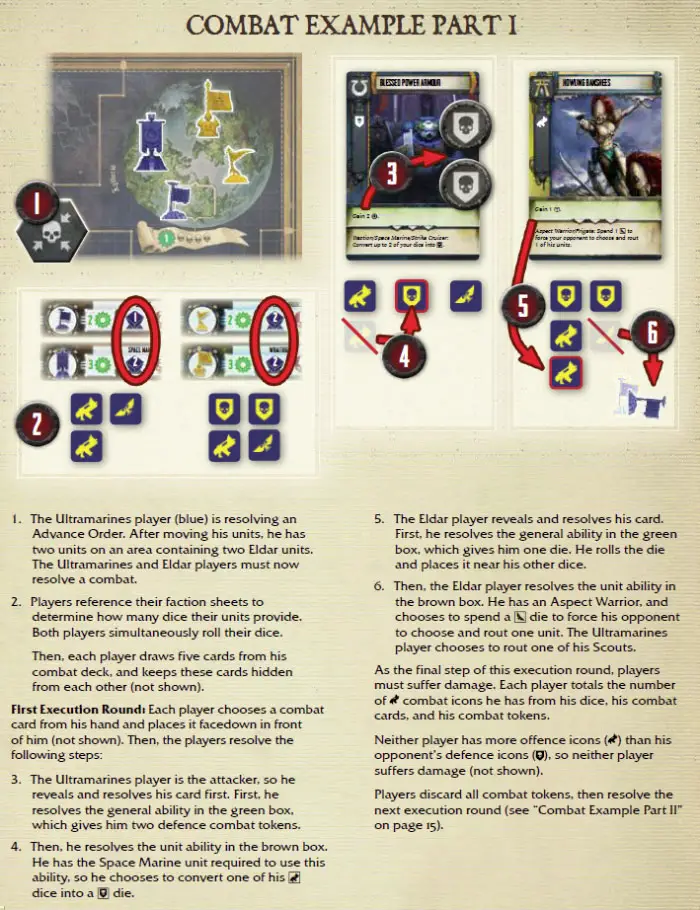
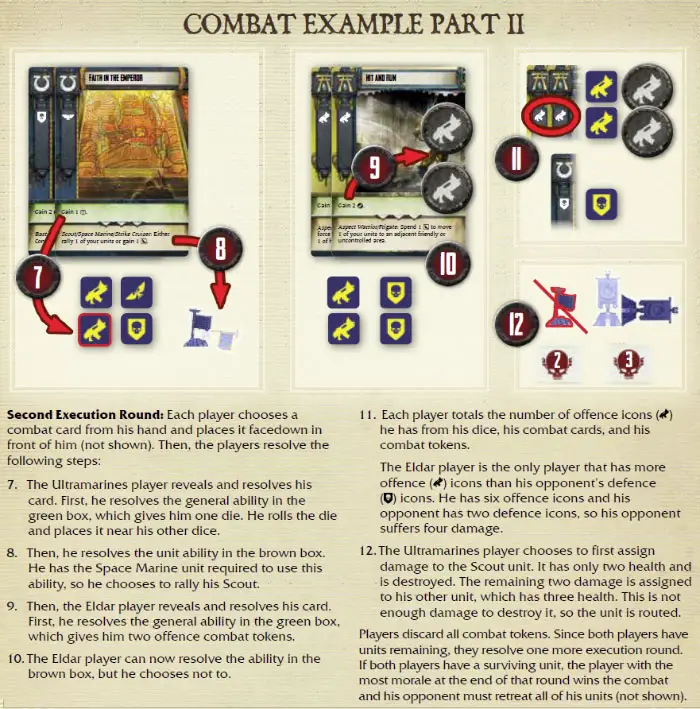
Retreating
Units must retreat when they lose a combat. Additionally, some combat card abilities can force units to retreat. After a unit retreats, it is routed.
Attacking and defending units follow different retreat rules, as follows:
-
Attacker Retreats
When the attacker retreats, he must move all of his remaining units from the contested area to another areaships must retreat to a void and ground units must retreat to a world along a legal movement path. All retreating units must move to the same area, and it must be an area that at least one unit in the combat moved from.
-
Defender Retreats
When the defender retreats, he must move all of his remaining units from the contested area to either a friendly or uncontrolled area in either the active system or an adjacent system-ships must retreat to a void and ground units must retreat to a world along a legal movement path. All retreating units must move to the same area.
If the defender is able to retreat to both a friendly and an uncontrolled area, he must retreat to the friendly area.
Continue Reading
